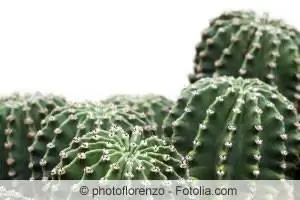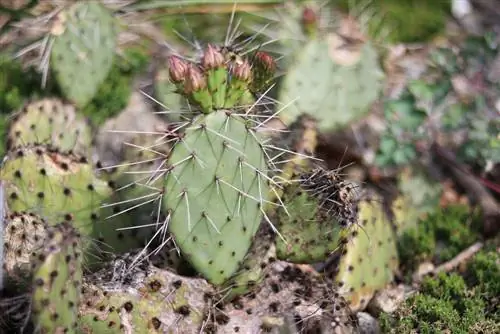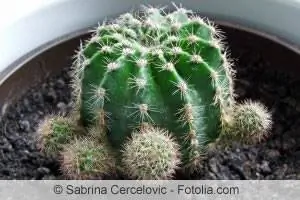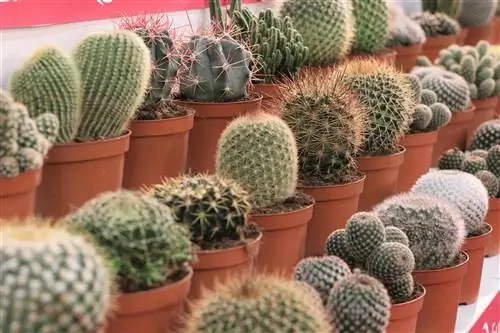- Author admin [email protected].
- Public 2023-12-17 03:39.
- Last modified 2025-10-04 22:41.
The fascinating world of Echinopsis cacti is surprisingly colorful. When they unfold their magnificent flowers in summer, which emit a lovely scent, they are in no way inferior in beauty to the classic summer flowers. It is the exciting combination of spiked dress and flower splendor that sparks the passion for collecting in so many hobby gardeners. Here you can familiarize yourself with the most beautiful species and varieties that the South American cactus family has to offer. Practical care tips also pave the way for beginners to successfully cultivate Echinopsis cacti.
Care tips
People often refer to the Echinopsis as a farmer's cactus. In earlier years, flowering specimens could often be discovered on the window sills of hard-working farmers' wives who didn't have much time for extensive flower care but didn't want to miss out on a little colorful variety. From this it can easily be concluded that Echinopsis cacti are among the frugal specimens among the prickly succulents. The following care tips show what is essentially important.
Location
The closer the site conditions are to the climatic conditions of their South American homeland, the more opulent Echinopsis develop. Ideally, a suitable window seat or, in summer, a place on the balcony is available. Thanks to their green plant bodies, the succulents can tolerate a few hours of sunshine:
- An east or west window is optimal
- Maximum 80-100 centimeters from the window
- From May to September on the sunny balcony
- As protected as possible from the pelting rain
In October, Echinopsis cacti move to their winter quarters. They want to stay there cool for the next 4-6 months, at temperatures between 2 and 12 degrees Celsius. There should be a little light so that there is no need for a laborious adjustment phase in the spring. There is no watering or fertilization during this rest period. From March onwards, the little scratching brushes are woken up from their hibernation and gradually prepared for the new outdoor season.
Substrate

Passionate cactus lovers can discuss the subject of substrate for hours. Over the years, experts have developed their own individual blends. As a rule of thumb, the best cactus soil is well-drained, not compacted and gradually releases the absorbed nutrients and water back into the roots. The following recipes have proven themselves:
- 30-60 percent commercial cactus soil, mixed with mineral components
- Suitable additions are pumice gravel, lava granules, vermiculite, coconut fibers, perlite and sand
TKS1 (peat culture substrate) and pricking soil serve as an alternative to cactus soil, due to their lower proportion of humus compared to potting soil.
Tip:
Cactus substrate with a pH value greater than 7 is absolutely deadly for any Echinopsis. A simple pH value test is therefore recommended before a new mixture is used.
Watering and fertilizing
A key characteristic of cacti is the enormous water storage they are capable of as succulents. Watering is preferably carried out according to this rhythm:
- From March onwards, spray Echinopsis with water from time to time
- Gradually increase the amount of irrigation water until May
- Watering alternately and allowing to dry thoroughly
- From September onwards, reduce the amount of water again until it completely ends in the winter quarters
If you prefer overwintering on the windowsill, water the cactus every now and then so that the root ball does not dry out completely. Basically, you should never water under the blazing midday sun, but rather in the morning or in the evening.
Tip:
Ideally, collected rainwater is available for watering cacti. Hard tap water should first be softened to a pH value of 5.5 to 6.5.
In order for a farmer's cactus to develop its pretty flowers, it needs a balanced supply of nutrients. Special liquid fertilizers are available from specialist retailers that are tailored precisely to your needs. Administer this preparation every one to two weeks from May to September.
Beautiful species and varieties

Echinopsis adolfofriedrichii
The species retains its spherical habit and grows to a maximum height of 15 centimeters with a diameter of 10 centimeters. A brilliant white flower rises above it in summer. It easily reaches a size of 13 centimeters on a stem that is up to 20 centimeters long. The ideal plant for night owls, because the flowers only open in the evening hours.
Echinopsis eyriesii
Native to Argentina, this species enchants the summer balcony with a pink-white flower on a stem that is up to 25 centimeters long. Their very strong thorns make necessary care work a gauntlet.
Echinopsis ferox
The dramatic habit is characterized by curved thorns up to 18 centimeters long. The spherical plant body reaches a height of 30 centimeters. Above it rises a beautiful flower in white, pink, yellow or red.
Echinopsis huascha
With a growth height of up to 1 meter and lush branching, these farmer cacti take up a lot of space. While most species and varieties develop star-shaped flowers, these tend to be funnel to bell-shaped in a rich pink.
Echinopsis chrysantha
With a growth height of 4 to 6 centimeters, this cactus appears tiny. Nevertheless, it has pretty yellow-orange flowers that are on display during the day. This species is therefore the perfect candidate to introduce interested children to the topic.
Echinopsis backebergii var. winteriana
As this species does not sprout, it thrives best in small pots and blooms in a wonderful pink with a white throat. If you would like to try sowing Echinopsis, this specimen will do it particularly well. Germination begins here within 3-5 days.
Echinopsis schieliana
If you want a farmer's cactus with a cushion-forming character, you will find the perfect aspirant here. With a growth height of 5 centimeters, there are numerous balls with a diameter of 3-4 centimeters. Dainty flowers in red or yellow decorate the appearance in summer.
Echinopsis peruviana
One of the largest species, if well cared for in the right location, reaches a height of 3 meters and produces flowers with a diameter of 25 centimeters. The 4 centimeter long thorns should not be underestimated.
Rheingold hybrids
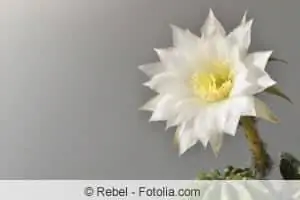
At the end of the 1960s, an ambitious working group created a family of varieties that combined old breeds with American Paramount hybrids. The result was the wonderful Rheingold hybrids, among which all conceivable shades of red dominate in the flowers. Some examples:
- Sonata: white outside, pink inside with a diameter of 10 centimeters
- Cardinal: pinkish red with purple border and pink central stripe
- Bellissima: bright white flower with magenta stripe
- Arabelle: spectacular with reddish-yellow center, crimson border and yellowish central stripe
Schick-Hybrids
They are the premium brands among the Echinopsis cacti. Developed by the famous breeder Bob Schick, these varieties are traded for high sums worldwide. Beautiful specimens are:
- Daydream: bicolor flower in yellow-orange and pink with dark-pink central stripe
- Coquette: light yellow, wonderfully fragrant flowers over round plant body
- Consolation: yellow, pink-fading flowers above barrel-shaped plant body
- Elegant Lady: White flower inside, fading into pink-purple towards the edge
- Lipstick: glamorous shiny petals in bright red
Conclusion
For hobby gardeners with an interest in cactus culture, Echinopsis are an excellent choice to start with. Undemanding in care, robust in constitution and equipped with beautiful flowers, this genus often marks the beginning of a long friendship. Anyone who has a passion for collecting will find a variety of spectacular species and varieties within the large family of farmer's cacti.

